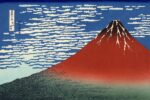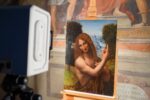Visto da qui – Donatella Spaziani
.jpg)
La prossima fase del progetto, inizia con Donatella Spaziani e il suo ciclo di opere Autoscatti presentato nel 2004 alla mostra “Forse Italia” a cura di Eva Wittocx, presso S.M.A.K., Ghent, Belgio.
Comunicato stampa
Visto da qui è stata una precoce occasione per riflettere sulla struttura della galleria stessa e del fare mostre, con l’obiettivo di eliminare quel surplus generato da una sempre più evidente sovrapproduzione di contenuti e riportando l’attenzione esclusivamente sulle opere.
Dopo quindici episodi che hanno permesso il confronto con oltre cinquanta opere, Visto da qui ripartirà con la sua struttura poliedrica e a più livelli del progetto, cercando di indagare ancora le questioni e le problematiche sollevate, adattandosi alle nuove modalità di fruizione e condivisione della galleria.
L’apertura della nuova sede, Casa Di Marino, in Via Monte di Dio 9, infatti, impone una rimodulazione e diversificazione della programmazione; ragion per cui lo spazio di Via Alabardieri riprende la via di una trasformazione già anticipata. I nuovi progetti espositivi, ospitati nella sede storica della galleria, tra cui Visto da qui, saranno, infatti, realizzati con opere e artisti che abbiano già incrociato il loro percorso con la galleria. Occasione di riscoperta, analisi, studio e ridiscussione dell’attività della galleria, attraverso la lente della contemporaneità.
La prossima fase del progetto, inizia con Donatella Spaziani e il suo ciclo di opere Autoscatti presentato nel 2004 alla mostra “Forse Italia” a cura di Eva Wittocx, presso S.M.A.K., Ghent, Belgio.
Le opere, realizzate agli inizi degli anni 2000, durante la permanenza in diversi luoghi chiusi, come camere d’albergo o spazi abbandonati, indagano il rapporto fra corpo e spazio, inteso nell’accezione di luogo, abitato ed abitante che diventa esso stesso personaggio e protagonista.
I livelli di percezione seguono due direttive, quella concettuale e progettuale, figlia dell’osservazione del luogo, senza la diluizione del contatto con l’esterno, e quella del corpo che entra in relazione con lo spazio e con gli oggetti che lo abitano. La dimensione del corpo si lega alla casualità del movimento che avviene nel tempo dell’autoscatto, che diventa strumento conoscitivo attraverso cui l’artista percepisce lo spazio fisico del luogo chiuso, e della città, che vede solo attraverso il filtro della finestra e, quindi, della propria immaginazione. Il rapporto fra il corpo, lo spazio e il tempo in cui quest’ultimo viene abitato, diventa linguaggio e strumento narrativo. La chiusura in luoghi diversi, volontaria e ricercata, oppure obbligata e forzata, diventa protagonista dell’esplorazione formale e personale dell’Io e del rapporto con il mondo e con i luoghi. Gli ambienti e gli oggetti si piegano alle esigenze dell’artista, astraendosi dal luogo fisico e diventando così mezzo e strumento di ricerca interiore. Così come il nostro rinnovato rapporto con gli ambienti interni e domestici, e con il tempo, che in questi luoghi sembra mutare e adottare una connotazione quasi a-temporale.
“Intuisco che sto cercando una forma ma mi accorgo di lavorare con il tempo”, riporta la Spaziani. Il tempo, l’altro grande protagonista della ricerca, per l’artista è diviso in 3 sezioni, il tempo del viaggio per il raggiungimento del luogo designato, il tempo della permanenza nella stanza e il tempo, ancor più limitato dell’autoscatto che dà finalmente spazio all’improvvisazione e all’istinto. Quest’ultimo tempo, di cui vediamo il risultato più tangibile, altro non è che la forza di un istante, la volontà, a volte di ribellione, a volte di stasi, che genera l’immagine risultante del processo.
Visto da qui was an early opportunity to reflect on the structure of the gallery itself and of making exhibitions, with the aim of eliminating that surplus generated by an increasingly evident overproduction of content and bringing the focus back exclusively to the works.
After fifteen episodes that allowed dialogue with more than fifty artworks, Visto da qui will continue with its polyhedral and multi-layered structured project, going further into researching the issues and questions that came about, adapting to new methods of ejoyment and sharing of the gallery.
The opening of the new space, Casa Di Marino, in Via Monte di Dio 9, requires a reshaping and diversification of the program; reason why the space in Via Alabardieri resumes the path of a transformation that had already been anticipated. The new exhibition projects, hosted in the gallery's historical location, including Visto da qui, will, in fact, be realized with works and artists who have already crossed their path with the gallery. An opportunity for rediscovery, analysis, study and re-discussion of the gallery's activity, through the lens of contemporaneity.
The next phase of the project, starts with Donatella Spaziani and her cycle of works Autoscatti presented in 2004 at the exhibition "Forse Italia" curated by Eva Wittocx, at S.M.A.K., Ghent, Belgium.
The works, realized in the early 2000s while staying in several closed locations, such as hotel rooms or abandoned spaces, investigate the relationship between body and space, meant in the sense of place, both inhabited and inhabitant, becoming character and protagonist in and of itself.
The levels of perception follow two directives, that of the concept and design which is the child of the observation of the place, without the dilution of contact with the outside, and that of the body, which enters into a relationship with the space and the objects that inhabit it. The sphere of the body is linked to the randomness of movement that occurs in the time of the self-timer, which becomes a cognitive tool through which the artist perceives the physical space of the enclosed place, and of the city, which she sees only through the filter of the window and, therefore, through her own imagination. The relationship between the body, the space and the time in which the latter is experienced, becomes language and narrative tool. Enclosure in different places, whether voluntary and sought, or forced and compelled, becomes the protagonist of the formal and personal exploration of the self and the relationship with the world and places. Environments and objects yield to the requirements of the artist, abstracting from the physical place and thus becoming a means and tool of inner research. So does our renewed relationship with interior and domestic environments, and with time, which in these places seems to change and adopt a kind of a-temporal connotation.
"I feel that I am looking for a form but I realize that I am working with time," Spaziani notes. Time, the other great protagonist of the research, for the artist is partitioned into 3 sections, the time of the journey to reach the designated place, the time of the stay in the room, and the even more limited time of the self-timer that finally gives space to improvisation and instinct. The latter time, of which we see the most tangible result, is nothing but the force of an instant, the will, sometimes of rebellion, sometimes of stasis, that generates the resulting image of the process.



